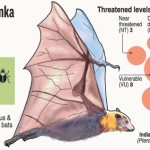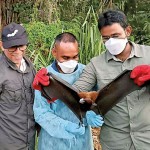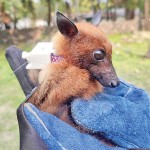News
Study of bats hunts for clues on viruses harmful to humans
View(s):By Kasun Warakapitiya
Scientists are hoping to use the findings of a study of flight routes of bats and the correlation to the spread of deadly viruses to form an early warning system for disease outbreaks.
In an inaugural study of large bat flight pathways in Sri Lanka, scientists had attached GPS collars on flying foxes (Pteropus medius) to track their nighttime flights and assess the risk of dangerous virus outbreaks that could affect the health of the general public.
The ongoing study is under an IDEA net project, which is done through a collaboration between the University of Colombo, the Ministry of Health, the Open University of Sri Lanka and the Robert Koch Institute of Germany, on identifying emerging infectious diseasevipus in Sri Lankan wildlife and unidentified diseases in patients.
- Prof Saminda Fernando
- Chamara Amarasinghe
- Prof Inoka C Perera
- Prof Wipula Yapa
Prof Inoka C Perera, who leads the research team from the University of Colombo, said the project had been underway since 2017 to understand flight patterns, distributions of bats and how it relates to the spread of virus-borne diseases, which could be a threat to people. They learned that the bats can fly up to 60 kilometres on average in a night, and some fly hundreds of kilometres to visit bat colonies along the way.
According to Chamara Amarasinghe, who is a PhD student of the project, around 14 bats had been collared so far, and their flight patterns have been mapped and are being analysed. “The bats travel more than 50 kilometres a night.’’
Prof Perera explained that the Robert Koch Institute is carrying out genetic sequencing for identifying diseases, as it has the technology and biosafety protocols.
The study also revealed that some Sri Lankan bats also carry the Nipah virus (Henipavirus nipahense), like the Indian counterparts. The scientists discovered bats carrying the virus in two bat colonies under the PhD study of Dr Sahan Siriwardana. “The virus is present in few bat samples taken in March, but not in other months. We don’t have any human cases reported to date in Sri Lanka.
“The virus was directly contracted by people in Kerala, as the people had eaten fruit and drunk toddy, which had been lapped up by bats.”
It was also learned that the spread of the virus was also related to the stress levels in the bats, as bats with higher cortisol (stress hormone) levels shed the virus.
But, in Sri Lanka, there were no reports of human infections, and there were indications that stress levels in large bats are significantly lower in Sri Lanka due to the mild climate and favourable habitat.
The scientists had also expanded the research on the flight range of bats and also observed whether the large bats fly to India and other South Asian countries and whether they bring the Nipah virus from other countries.
Saminda Fernando, a professor of zoology at the Faculty of Natural Sciences of the Open University of Sri Lanka, explained that the study also was focusing on the ecology and taxonomical status of the bat.
He added that though the flying foxes are scientifically identified as (Pteropus medius) “Indian Flying Fox” by a foreign group of researchers, a local scientific study had not been done.
Therefore, the research team, with the permission and support of the Department of Wildlife Conservation and the Ceylon Electricity Board, had started to collect carcasses of electrocuted bats to collect skulls for a taxonomic study to see if the fruit bat in Sri Lanka is a unique species.
Prof Fernando said blood samples would also be collected when bats were captured and released during GPS collaring.
Other details have been found through blood profiling, including diet and nutrition. Also some bats do not travel far if food is aplenty.
In addition, the research also looks into ways of conserving fruit bats and their habitat, because large numbers have been electrocuted.
“While we were collecting samples of carcasses of bats electrocuted while roosting on power cables, we found 78 carcasses within a three-kilometre stretch,” he said.
Retired Professor Wipula Bandara Yapa and Dr Tharaka Kusuminda, who are bat ecologists, told The Sunday Times that the knowledge gathered would be used to conserve the large fruit bats.
They explained that the large fruit bats are night-time pollinators and seed dispersers who greatly contribute to the maintenance of forest cover.
According to Prof Yapa, bats too play an important role in pollination at night when bees are inactive. Apart from that, he explained that there are specific plants which are only pollinated by bats.
The research team comprises expert virologists Prof Andreas Nitsche, Dr Claudia Kohl, and molecular biologist Prof. Sunil Premawansa; experts of biodiversity conservation and bat ecology Rtd Prof Wipula Yapa, Prof Saminda Fernando, Dr Sahan Siriwardana, Mr Chamara Amarasinghe, Dr Sujanthe Mauran, and Dr Tharaka Kusuminda.
The best way to say that you found the home of your dreams is by finding it on Hitad.lk. We have listings for apartments for sale or rent in Sri Lanka, no matter what locale you're looking for! Whether you live in Colombo, Galle, Kandy, Matara, Jaffna and more - we've got them all!









